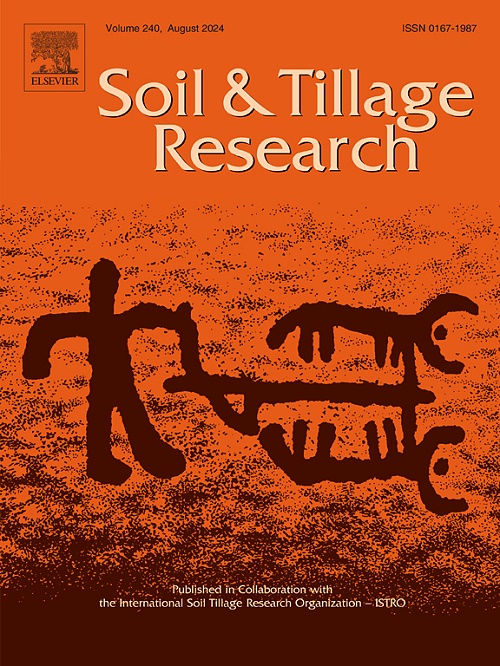Improving ratoon rice grain yield and soil carbon pools in subtropical regions through integrated crop and soil management practices
IF 6.8
1区 农林科学
Q1 SOIL SCIENCE
引用次数: 0
Abstract
Integrated crop and soil management measures have proven effective in enhancing crop yields and resource use efficiency, although the impacts on soil carbon pools and related microbial diversity remain unclear. In this study, we compared rice yield and soil properties between a local ratoon rice farming practice model without organic fertilizer application (FP) with an improved farming practice model (IFP) based on integrated management practices, including a > 20 % increase in planting density, 30 % increase in panicle fertilization, and application of 1.8 t/ha of organic fertilizer, in Hunan Province, China. The 5-year average annual rice grain yield was 32.0 % higher in the IFP (13.3 t/ha) than in the FP. Soil organic carbon (SOC) content was nonsignificantly higher by 9.2 % in the IFP (22.4 g/kg) than in the FP; furthermore, the labile organic carbon and dissolved organic carbon contents were 10.7 g/kg and 45.5 mg/kg, respectively, in the IFP, significantly higher than those of the FP and N-free control. The carbon pool management index in the IFP was 191.4 in 2022 and 132.9 in 2023, and was significantly higher by 95.0 % (P < 0.05) than in the FP; the carbon pool activity and carbon pool activity index were similarly improved in the IFP. The average microbial biomass carbon in the IFP was 179.3 mg/kg, but did not differ significantly among the IFP, FP, and control. The bacterial and fungal Chao1 indexes were 5.6 % and 13.3 % higher, respectively, in the IFP (Chao1 for bacteria: 5252.5; fungi: 2291.5) than in the FP. The bacterial and fungal abundance-based coverage estimator (ACE) indexes were 7.2 % and 13.3 % higher, respectively, in the IFP (ACE for bacteria: 5871.5; fungi: 2530.4) than in the FP; however, there was no significant difference between the IFP and FP (P > 0.05). These results support the efficacy of integrated agronomic measures in greatly increasing rice grain yield while supporting soil fertility through enhancing carbon pools and related microbial diversity. As modern ratoon rice production becomes increasingly mechanized, such measures will become easy to adopt.
通过作物和土壤综合管理措施提高亚热带地区冬稻产量和土壤碳库
作物和土壤综合管理措施已被证明在提高作物产量和资源利用效率方面是有效的,尽管对土壤碳库和相关微生物多样性的影响尚不清楚。在本研究中,我们比较了在中国湖南省不施用有机肥的地方再生稻耕作模式(FP)与基于综合管理实践的改良耕作模式(IFP)的水稻产量和土壤性质,其中种植密度增加>; 20 %,穗肥增加30 %,有机肥施用1.8 t/ha。IFP的5年平均产量(13.3 t/ha)比FP高32.0 %。土壤有机碳(SOC)含量,IFP处理(22.4 g/kg)较FP处理无显著性提高9.2 %;此外,IFP的活性有机碳和溶解有机碳含量分别为10.7 g/kg和45.5 mg/kg,显著高于FP和无氮对照。2022年和2023年IFP的碳库管理指数分别为191.4和132.9,显著高于FP的95.0 % (P <; 0.05);碳库活性和碳库活性指数在IFP中也得到了类似的改善。IFP的平均微生物生物量碳为179.3 mg/kg,但IFP、FP和对照之间差异不显著。IFP中细菌和真菌的Chao1指数分别提高了5.6 %和13.3 %(细菌的Chao1: 5252.5;真菌:2291.5)比FP多。细菌和真菌丰度覆盖估计(ACE)指数在IFP中分别高出7.2 %和13.3 %(细菌ACE: 5871.5;真菌:2530.4)比FP多;然而,IFP与FP之间无显著差异(P >; 0.05)。这些结果支持综合农艺措施在通过增加碳库和相关微生物多样性来大幅提高水稻产量的同时支持土壤肥力的有效性。随着现代再生稻生产的日益机械化,这些措施将变得容易采用。
本文章由计算机程序翻译,如有差异,请以英文原文为准。
求助全文
约1分钟内获得全文
求助全文
来源期刊

Soil & Tillage Research
农林科学-土壤科学
CiteScore
13.00
自引率
6.20%
发文量
266
审稿时长
5 months
期刊介绍:
Soil & Tillage Research examines the physical, chemical and biological changes in the soil caused by tillage and field traffic. Manuscripts will be considered on aspects of soil science, physics, technology, mechanization and applied engineering for a sustainable balance among productivity, environmental quality and profitability. The following are examples of suitable topics within the scope of the journal of Soil and Tillage Research:
The agricultural and biosystems engineering associated with tillage (including no-tillage, reduced-tillage and direct drilling), irrigation and drainage, crops and crop rotations, fertilization, rehabilitation of mine spoils and processes used to modify soils. Soil change effects on establishment and yield of crops, growth of plants and roots, structure and erosion of soil, cycling of carbon and nutrients, greenhouse gas emissions, leaching, runoff and other processes that affect environmental quality. Characterization or modeling of tillage and field traffic responses, soil, climate, or topographic effects, soil deformation processes, tillage tools, traction devices, energy requirements, economics, surface and subsurface water quality effects, tillage effects on weed, pest and disease control, and their interactions.
 求助内容:
求助内容: 应助结果提醒方式:
应助结果提醒方式:


